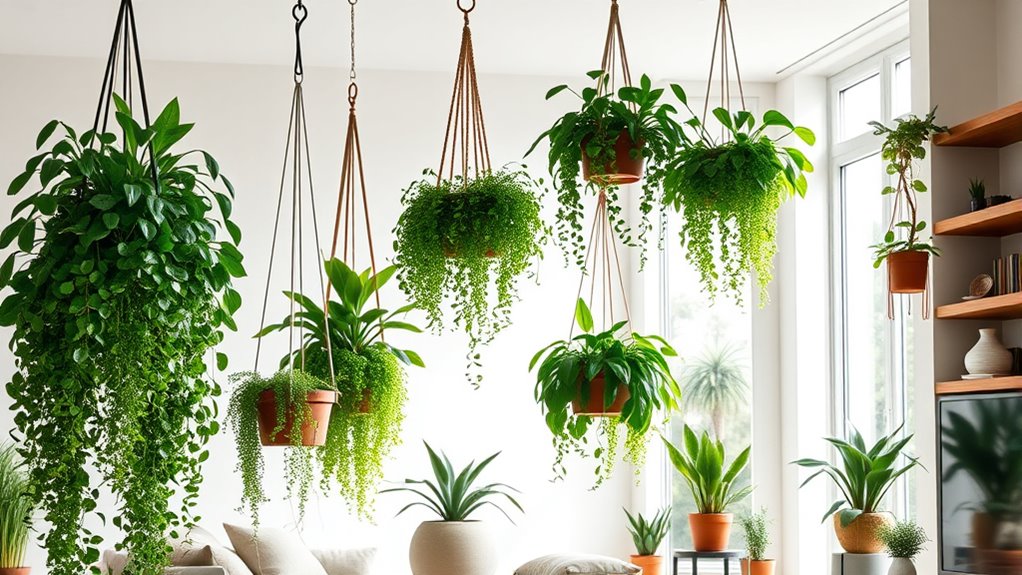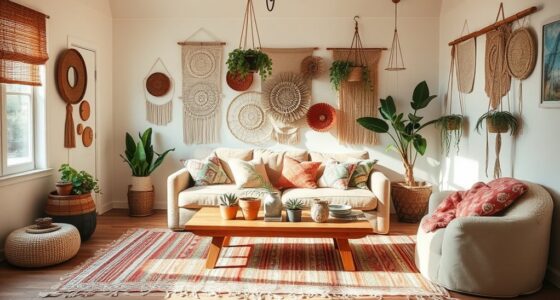To enhance your indoor hanging plants, choose lightweight, stylish pots like resin or plastic, and secure sturdy hangers such as macramé or metal hooks. Position your plants near filtered light or brighter spots at eye level for easy care and visual appeal. Regularly monitor soil moisture to prevent over- or underwatering, and adjust placement based on light needs. If you want to discover more tips for thriving indoor greenery, keep exploring further techniques and tricks.
Key Takeaways
- Choose lightweight pots like plastic or resin for easy hanging and support.
- Use stylish hangers such as macramé or sleek metal hooks for aesthetic appeal.
- Position plants near filtered light sources, at eye level or slightly above for visibility.
- Ensure hangers and pots are sturdy enough to support the plant’s weight when moist.
- Regularly monitor soil moisture and adjust placement to match each plant’s light and watering needs.

Hanging plants are a stylish and practical way to bring greenery into your indoor space. They add a touch of nature and freshness without taking up valuable surface area. To keep your hanging plants thriving, you need to pay attention to their watering schedule and light requirements. These factors are essential for healthy growth and vibrant foliage. Setting a consistent watering routine ensures your plants don’t suffer from overwatering or dehydration. Most hanging plants prefer their soil to dry out slightly between waterings, so check the top inch regularly. Stick to a schedule where you water when the soil feels dry, usually once a week. However, be mindful that some plants, like pothos or philodendrons, may need watering every 5 to 7 days, especially if your home is warm or dry. Conversely, plants like ferns or certain ivies might require more frequent watering. Adjust your routine based on your plant’s specific needs and the environment.
Light requirements are equally important. Hanging plants often sit in spots where they receive varying levels of natural light, so understanding what your plant prefers helps it flourish. For example, many popular indoor hanging plants thrive in bright, indirect light. If your space gets a lot of direct sunlight, you might want to hang your plants where they’re protected from harsh rays to prevent leaf scorch. On the other hand, low-light tolerant plants, such as pothos or snake plants, can survive in shaded corners or areas with artificial light. Observe your space and choose your plants accordingly, or move them around to find the ideal spot.
When selecting pots and hangers, consider both functionality and style. Lightweight materials like plastic or resin make hanging easier, especially if you’re frequently adjusting placement. Macramé hangers or sleek metal hooks can complement modern decor, while colorful ceramic pots add vibrancy. Ensure your hanging system is sturdy enough to support the weight of your plant and container, especially once the soil is moist and heavier. Position your plants at eye level or slightly above to enjoy their lush foliage and to make watering easier. Keep in mind that placement affects light exposure; near a window with filtered light is often ideal for many hanging plants.
Frequently Asked Questions
Which Indoor Plants Are Easiest for Beginners?
You’ll find succulents and low light options are the easiest indoor plants for beginners. Succulent varieties like aloe vera and jade thrive on minimal water and sunlight, making them low-maintenance. Low light plants such as pothos or snake plants adapt well to indoor environments with limited sunlight. These plants are forgiving if you forget to water them occasionally and require simple care, making them perfect choices for beginners.
How Often Should I Water Hanging Indoor Plants?
You should water your hanging indoor plants when the soil moisture feels dry about an inch below the surface. Typically, this means watering once a week, but it can vary based on factors like light, humidity, and pot type. Check the soil regularly, and avoid overwatering, which can lead to root rot. Adjust your watering frequency as needed to keep the soil moist but not soggy.
What Are the Best Lighting Conditions for Indoor Hanging Plants?
Your hanging plants thrive best in bright, indirect light, which is like a gentle hug from the sun. Aim for a spot near a window with filtered light or where they receive several hours of morning or late afternoon sun. Avoid harsh, direct sunlight that can scorch leaves. Adjust window placement based on light intensity, ensuring they get enough light without overexposure. This way, your plants stay lush and vibrant!
Are There Pet-Safe Hanging Plants for Homes With Animals?
Yes, you can choose pet-safe greenery to keep your pets safe. Look for hanging plants that are pet friendly and avoid pet toxic plants. Plants like spider plants, Boston ferns, and Calathea are great options because they’re non-toxic to animals. Always double-check any plant’s safety before bringing it into your home, and place your pet-friendly hanging plants where your pets can’t chew or disturb them.
How Can I Prevent Pests on My Indoor Hanging Plants?
Did you know that over 50% of indoor plant owners face pest issues? To prevent pests on your hanging plants, regularly inspect for signs of infestation and keep leaves clean. Use natural repellents like neem oil or diluted dish soap, which are safe for pets and effective. Proper airflow around your plants also discourages pests, so make sure good ventilation. Consistent pest prevention steps keep your indoor greenery healthy and pest-free.
Conclusion
Hanging plants can transform your indoor space into a lush, vibrant oasis. By choosing the right pots, hangers, and placement, you’ll create a beautiful, healthy environment. Did you know that adding indoor plants can boost your mood and reduce stress by up to 15%? So, go ahead—embrace hanging plants and enjoy the natural beauty and wellness benefits they bring into your home. Your space will feel more lively and inviting in no time.









